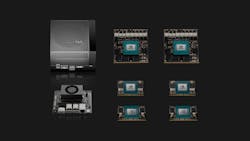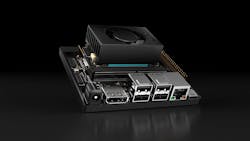Packing AI Acceleration into a Compact Module
NVIDIA extended its Jetson family at the low end, which ranges from the Jetson Orin Nano to the Jetson AGX Orin (Fig. 1). Scaling from 40 to 275 TOPS, the modules use as little as 7 W of power at the low end. The compact modules are ideal for applications such as drones and robotics and various IoT solutions, including video analysis for intelligent vision AI systems. The Jetson family supports frameworks like the Robot Operating System (ROS) 2.
Though the Jetson Orin Nano Developer Kit may be compact, it packs a punch, delivering 40 TOPS of performance using a collection of 1,024 NVIDIA Ampere GPU cores, 32 Tensor cores, and six 64-bit Arm Cortex-A78AE cores consuming 15 W of power (Fig. 2). The kit provides a module that has 4 or 8 GB of DRAM capacity. The smaller version has 512 Ampere cores and 16 Tensor cores; the module needs only 7 W of power.
The module incorporates a microSD UHS-1 card socket (bring your own microSD card). And the carrier board adds support for M.2 x4 NVMe flash-memory storage and access to the module's Gigabit Ethernet port and USB 3.2 Gen 2 ports. A USB Type-C port is used for debugging. In addition, a DisplayPort 1.2 interface provides display support.
The carrier board measures 100 × 79 × 21 mm, including the module and heatsink. There's a 40-pin expansion header and a 12-pin button header. Two 2x MIPI CSI-2 22-pin camera connections also are in the mix. The underside of the carrier board is where the M.2 sockets are located. There's a full size M.2 x4 NVME socket and two compact M.2 sockets as well. Also, a x2 PCIe M.2 Key M socket and an M.2 Key E socket is filled by a wireless module that provides Bluetooth and Wi-Fi support.
While the power and performance specs are great, the list of compatible software is more impressive. Development can be done using the NVIDIA JetPack SDK. It works with frameworks like the NVIDIA Riva conversational AI and NVIDIA DeepStream SDK vision support.


